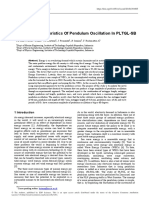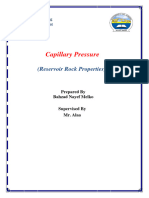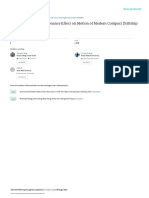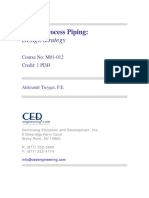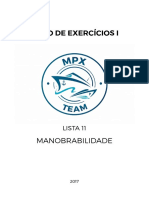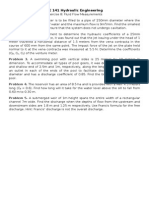Conclusion, Recommendatio and Apendix
Conclusion, Recommendatio and Apendix
Uploaded by
Syahmi AkmalCopyright:
Available Formats
Conclusion, Recommendatio and Apendix
Conclusion, Recommendatio and Apendix
Uploaded by
Syahmi AkmalOriginal Description:
Copyright
Available Formats
Share this document
Did you find this document useful?
Is this content inappropriate?
Copyright:
Available Formats
Conclusion, Recommendatio and Apendix
Conclusion, Recommendatio and Apendix
Uploaded by
Syahmi AkmalCopyright:
Available Formats
Conclusion
These experiments were carried out to determine a forced vortex's surface profile and to
investigate the physical phenomena associated with free vortex. A vortex observation that formed and
found that small pilot tube diameter created small vortex while large orifice diameter created larger
vortex. The speed of vortex circulation depends on the size of the pilot tube, respectively, slow,
moderate and fast. The result was obtained as the average velocity head, hc for the complete
revolution in the forced vortex test.
In this experiment, Hydraulic Bench Service Module and Free Force Vortex Apparatus was
used in order to achieve the objectives of this experiment. All the requirements associated with both
forced and free vortices have been identified. From the result of this experiment, the conclusion that
can be drawn here is that the vortex formation depends on the size of the orifice used. The orifice may
be destroyed if some core object blocks water flow through the orifice.
The results of this experiment may deviate from the information found from the theory. The
results of this experiment may be unreliable due to certain factors such as human errors, equipment
performance and other factors.
In conclusion, the objective is achieved. As the rotation increase, the radius of a vortex
surface at the axis also will increase. From the results, graph for the three different speed, the
theoretical value for depth at different vortex radius is slightly lower than the actual value. Overall, it
can be seen that the depth of the vortex surface, Z is inversely proportional to the radius of vortex, r.
Recommendations
Repeat the experiment at least twice to get more accurate result, the more data we can make
comparison to determine the best result that can be pointed out. Next, error might while taking the
time for the number of revolutions since the paddle that created the forced to the vortex is rotated at
fast rate and this is difficult for us to get the accurate time. It is best to get the time average.
Furthermore, the velocity of water needs to be constant to get the best result so the water flow needs
to be adjusted and be watched for the whole experiment. Next, we must make sure that the needles
touch the water surface accurately to get precise data to be used in the further calculations. It is
important to make sure that the apparatus is in the good condition. It will affect the result if the
apparatus not in good condition. Lastly, when we measure the length of the needles, use appropriate
ruler such as long ruler and try to get the average reading which is more accurate.
References
1) Cengel, Y.A. & Cimbala J.M (2006). Fluid Mechanics: Fundamentals and Applications.
Flows in pipes. New York: McGraw Hill, (324).
2) Lab Manual CHE 486 Kejuruteraan Kimia Universiti Teknologi Mara
3) Forced Vortex. (n.d.). Retrieved from
https://www.sciencedirect.com/topics/engineering/forced-vortex.
4) Forced Vortex. (n.d.). Retrieved from
https://www.sciencedirect.com/topics/engineering/forced-vortex.
You might also like
- Centripetal Force Lab ReportDocument7 pagesCentripetal Force Lab ReportAmeer SulimanNo ratings yet
- Experiment 10 - Pendulum and Calculation of GDocument11 pagesExperiment 10 - Pendulum and Calculation of GYaashiNo ratings yet
- Testing and Commissioning of A Low-Speed (Incompressible), Subsonic, Transonic, andDocument7 pagesTesting and Commissioning of A Low-Speed (Incompressible), Subsonic, Transonic, andMj Santos100% (1)
- KonklusiDocument5 pagesKonklusinazirulNo ratings yet
- Investigation of Centripetal ForceDocument5 pagesInvestigation of Centripetal Forcemattcee0% (1)
- Hydraulic JumpDocument5 pagesHydraulic JumpSteve MachukiNo ratings yet
- Uniform Circular Motion: Lab ReportDocument16 pagesUniform Circular Motion: Lab Reportapi-439201634No ratings yet
- Lab VortexDocument22 pagesLab VortexaminsubriNo ratings yet
- Lab VortexDocument13 pagesLab VortexDaniel RazakNo ratings yet
- Lab 3-FREE N FORCE VORTEXDocument18 pagesLab 3-FREE N FORCE VORTEXfahmirased100% (1)
- Experiment8 JOSHUA TO EHDocument11 pagesExperiment8 JOSHUA TO EHPauSomerhalderNo ratings yet
- Free and Forced VortexDocument8 pagesFree and Forced Vortexsmh khanNo ratings yet
- Special Lab Report 2 Simple PendulumDocument15 pagesSpecial Lab Report 2 Simple Pendulumapi-656454154No ratings yet
- INV2019-24439 - Conservation of Linear Momentum Lab - Tracked ChangesDocument7 pagesINV2019-24439 - Conservation of Linear Momentum Lab - Tracked ChangesNyamai Kyalo CharlesNo ratings yet
- Advances in Environmental Biology: Experimental Study of Longitudinal Velocity Gradient in Submerged Hydraulic JetDocument6 pagesAdvances in Environmental Biology: Experimental Study of Longitudinal Velocity Gradient in Submerged Hydraulic JetWilliam ThomasNo ratings yet
- Lab Report FluidDocument27 pagesLab Report FluidAuzaNo ratings yet
- Hydraulic Laboratory Manual: Philadelphia UniversityDocument45 pagesHydraulic Laboratory Manual: Philadelphia UniversityRacknarockNo ratings yet
- The Round Turbulent Jet (Fluid Exp 7)Document7 pagesThe Round Turbulent Jet (Fluid Exp 7)hayder alaliNo ratings yet
- Experiments With Weathering, Erosion and Deposition For The Earth Science Regents CourseDocument10 pagesExperiments With Weathering, Erosion and Deposition For The Earth Science Regents CourseLembert CasinilloNo ratings yet
- Journal 1Document8 pagesJournal 1026 sandyNo ratings yet
- 1990 Sca Conference Paper Number 9013Document57 pages1990 Sca Conference Paper Number 9013Munif ThalibNo ratings yet
- Capillary Pressure: (Reservoir Rock Properties)Document13 pagesCapillary Pressure: (Reservoir Rock Properties)Saroo MusicNo ratings yet
- Simple Pendulum Lab ExperimentDocument7 pagesSimple Pendulum Lab ExperimentirisiraqNo ratings yet
- Free and Forced VortexDocument2 pagesFree and Forced VortexFatin Izzati HasnanNo ratings yet
- Hands On Education System Using Water RocketDocument5 pagesHands On Education System Using Water Rocketazam.cheNo ratings yet
- ExperimentDocument7 pagesExperimentShekharNo ratings yet
- An Experimental Study On Vortex Motion 2 ColumnsDocument15 pagesAn Experimental Study On Vortex Motion 2 ColumnsPrantik SinhaNo ratings yet
- Experiment 3: Specific Gravity of Solids ObservationDocument5 pagesExperiment 3: Specific Gravity of Solids ObservationMichael Jay RoganNo ratings yet
- Speciallab2 EmorrisDocument16 pagesSpeciallab2 Emorrisapi-666972723No ratings yet
- Analysis+of+Non Symmetrical+Flapping+AirfoilsDocument18 pagesAnalysis+of+Non Symmetrical+Flapping+AirfoilsAsif HameedNo ratings yet
- Impact of A JetDocument14 pagesImpact of A JetKamarul Yusri100% (4)
- Experiment No. 4 Hydrostatic Force On Submerged and Semi-Submerged Rectangular AreaDocument7 pagesExperiment No. 4 Hydrostatic Force On Submerged and Semi-Submerged Rectangular AreamonterdejanusleevonNo ratings yet
- An Experimental Study On Vortex Motion - Sent - ConferenceDocument12 pagesAn Experimental Study On Vortex Motion - Sent - ConferencePrantik SinhaNo ratings yet
- Grade 11 Physics: Mechanical Energy Investigation Factors Affecting A Pendulum's PeriodDocument11 pagesGrade 11 Physics: Mechanical Energy Investigation Factors Affecting A Pendulum's PeriodBlademeisterNo ratings yet
- Analysis Characteristics of Pendulum Oscillation in PLTGL-SBDocument8 pagesAnalysis Characteristics of Pendulum Oscillation in PLTGL-SBHoo Alfando Johan HandokoNo ratings yet
- Enphysl Post Lab Report 2 Group 1Document7 pagesEnphysl Post Lab Report 2 Group 1John SeñeresNo ratings yet
- Investigating The Effect of Liquid Viscosity On Two Phase Gas Liquid FlowDocument252 pagesInvestigating The Effect of Liquid Viscosity On Two Phase Gas Liquid FlowAnonymous DMh6pdl0aNo ratings yet
- Simple Pendulum Lab ReportDocument7 pagesSimple Pendulum Lab ReportSimiret DemiseNo ratings yet
- Capillary Pressure: (Reservoir Rock Properties)Document13 pagesCapillary Pressure: (Reservoir Rock Properties)Saroo MusicNo ratings yet
- Pendulum Coursework PhysicsDocument5 pagesPendulum Coursework Physicszpxjybifg100% (2)
- Processes 10 02362 v2Document13 pagesProcesses 10 02362 v2Anonymous 1AAjd0No ratings yet
- Ocean Engineering: Zhenshan Xu, Yongping Chen, Changkuan Zhang, Chi-Wai Li, Yana Wang, Fei HuDocument11 pagesOcean Engineering: Zhenshan Xu, Yongping Chen, Changkuan Zhang, Chi-Wai Li, Yana Wang, Fei HuZulFakriNo ratings yet
- 174 Zukoski EE 1966Document17 pages174 Zukoski EE 1966Darryan DhanpatNo ratings yet
- Gyroscopic Effect 2017 Journal of EnvironmentalDocument15 pagesGyroscopic Effect 2017 Journal of Environmentalaakash waychalNo ratings yet
- Study On Moonpool Resonance Effect On Motion of MoDocument9 pagesStudy On Moonpool Resonance Effect On Motion of MoMuhammad Rafiq RavinNo ratings yet
- Lab Report 5Document12 pagesLab Report 5i2brdiiNo ratings yet
- A Numerical Study of Bluff Body Aerodynamics in High Reynolds Number Flows by Viscous Vortex Element MethodDocument15 pagesA Numerical Study of Bluff Body Aerodynamics in High Reynolds Number Flows by Viscous Vortex Element MethodPCPCNo ratings yet
- Design and Development of Liquid Flow Test BedDocument19 pagesDesign and Development of Liquid Flow Test BedFrankie NovelaNo ratings yet
- Experimental Investigation On The Cavity Evolution and Dynamics With Special Emphasis On The Development Stage of Ventilated Partial Cavitating FlowDocument8 pagesExperimental Investigation On The Cavity Evolution and Dynamics With Special Emphasis On The Development Stage of Ventilated Partial Cavitating FlowQianZHNo ratings yet
- Formation of A Weak VortexDocument17 pagesFormation of A Weak VortexBharath kumarNo ratings yet
- Experiment 2 Fluid Properties: Viscosity: Jared ZeringueDocument11 pagesExperiment 2 Fluid Properties: Viscosity: Jared ZeringuejzeringuNo ratings yet
- Extended Essay Introduction - Thomas Jackson PDFDocument2 pagesExtended Essay Introduction - Thomas Jackson PDFThomas JacksonNo ratings yet
- ReflectionDocument2 pagesReflectiondeborahajaero2No ratings yet
- European Journal of Physics Volume 31 Issue 5 2010Document18 pagesEuropean Journal of Physics Volume 31 Issue 5 2010Guillermo Henry Ramirez UlloaNo ratings yet
- Phyla001midters PDFDocument7 pagesPhyla001midters PDFPiyanN8No ratings yet
- Simulation of Turbulent Flow Through Tarbela Dam Tunnel 3: M A, A A N H A WDocument24 pagesSimulation of Turbulent Flow Through Tarbela Dam Tunnel 3: M A, A A N H A WHugo GomezNo ratings yet
- Receipt of Lab Report Submission (To Be Kept by Student)Document4 pagesReceipt of Lab Report Submission (To Be Kept by Student)Dylan YongNo ratings yet
- Lab 2 mm222Document6 pagesLab 2 mm222pravishek maniNo ratings yet
- Ghulam Ishaq Khan Institute of Engineering Sciences and TechnologyDocument10 pagesGhulam Ishaq Khan Institute of Engineering Sciences and TechnologyWajid AliNo ratings yet
- Experiments on the Absence of Mechanical Connexion between Ether and MatterFrom EverandExperiments on the Absence of Mechanical Connexion between Ether and MatterNo ratings yet
- JIS B2313 Steel Plate Butt Welding Pipe FittingsDocument45 pagesJIS B2313 Steel Plate Butt Welding Pipe Fittingsnse mcxNo ratings yet
- Orifices DischargingDocument21 pagesOrifices DischargingKishan MadhooNo ratings yet
- Liquid Process Piping Design Strategy R2Document16 pagesLiquid Process Piping Design Strategy R2Masood Khan100% (1)
- Argo-hyto-filtration-HD040 HD081 HD150 40.05 EN US PDFDocument4 pagesArgo-hyto-filtration-HD040 HD081 HD150 40.05 EN US PDFhydrola 2021No ratings yet
- Sw3 Answer KeyDocument1 pageSw3 Answer KeyPati DukaNo ratings yet
- Reciprocating PumpsDocument10 pagesReciprocating PumpsMae Ann Dolor EstrellanaNo ratings yet
- Effects of Abnormal Conditions On The Accuracy of Orifice MeasurementDocument5 pagesEffects of Abnormal Conditions On The Accuracy of Orifice MeasurementAnonymous y3tPCbVrNo ratings yet
- Pressure Safety ValvesDocument11 pagesPressure Safety Valveschianhho100% (1)
- Pumps DynaJet DatasheetDocument2 pagesPumps DynaJet DatasheetdamiencwalkerNo ratings yet
- BS 1600Document2 pagesBS 1600visio2004No ratings yet
- Hydrodynamics Is The Branch of Physics That Studies The Behavior of Fluids in MotionDocument2 pagesHydrodynamics Is The Branch of Physics That Studies The Behavior of Fluids in MotionbennyNo ratings yet
- Ammendment To R2 BEPDocument13 pagesAmmendment To R2 BEPpratikNo ratings yet
- Reynold Number-ExamplesDocument25 pagesReynold Number-Exampleskhleifat_613891No ratings yet
- Chammas Chemical Cutter Size Page 28 To 32Document5 pagesChammas Chemical Cutter Size Page 28 To 32erwin atmadjaNo ratings yet
- Fluid Mach. Nos. 1 8 Part 1Document10 pagesFluid Mach. Nos. 1 8 Part 1Kim Howard CastilloNo ratings yet
- 11 Exercícios MAN PNA RES - PROP - CTR GABARITODocument125 pages11 Exercícios MAN PNA RES - PROP - CTR GABARITOandersondidoNo ratings yet
- 102Document1 page102ahm3d16n100% (1)
- Centrifugal PumpDocument20 pagesCentrifugal PumpHENRYGALLEGOSNo ratings yet
- 40 - Walvoil Sessões SDS180 - DLS180 - DesbloqueadoDocument76 pages40 - Walvoil Sessões SDS180 - DLS180 - Desbloqueadomoiseis88No ratings yet
- Lecture-4 Drilling EngineeringDocument18 pagesLecture-4 Drilling Engineeringحيدر بادي - Haider BadiNo ratings yet
- 5-1 Shock Waves and Expansion WavesDocument35 pages5-1 Shock Waves and Expansion WavesIndra KhandulukNo ratings yet
- TW580Document2 pagesTW580TAHRI BELGACEMNo ratings yet
- CE 141 Hydraulic EngineeringDocument1 pageCE 141 Hydraulic EngineeringAriel Dela CruzNo ratings yet
- Reynolds Number Effect On The Optimization of A Wind Turbine Blade For Maximum Aerodynamic EfficiencyDocument12 pagesReynolds Number Effect On The Optimization of A Wind Turbine Blade For Maximum Aerodynamic EfficiencyOmer Ghassan Abdulkareem Hassan AlsultanNo ratings yet
- Ref PVC Schedule80 IPS PlasticPipeDocument1 pageRef PVC Schedule80 IPS PlasticPipesirajuddin khowajaNo ratings yet
- Venturimeter Flow Measurrements NumericalsDocument29 pagesVenturimeter Flow Measurrements NumericalsRavi Kumar Verma100% (1)
- FISHER GX SST Control Valve-23Document1 pageFISHER GX SST Control Valve-23Javier Eduardo García MogollónNo ratings yet
- Comparison Between CFD Analysis and Experimental DataDocument4 pagesComparison Between CFD Analysis and Experimental Datalongtrandang5867No ratings yet
- IRP - Presentation Cranfield UniversityDocument30 pagesIRP - Presentation Cranfield Universitymitch182No ratings yet
- Clastic Transport and Fluid FlowDocument18 pagesClastic Transport and Fluid FlowAnonymous d6vkxJNo ratings yet


































